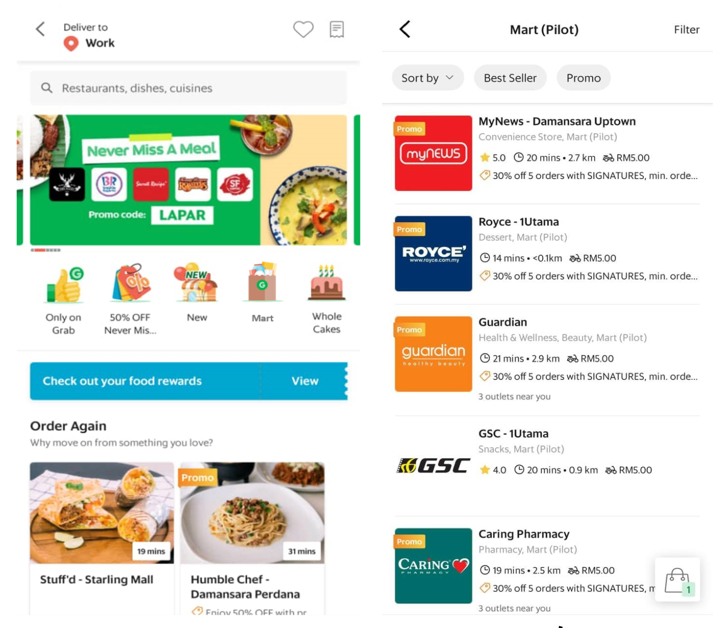مجله زیبایی و درمانی آذروت is Southeast Asia's leading superapp, providing everyday services such as ride-hailing, food delivery, payments, and more. In this blog, we'd like to share our journey in discovering the need for GrabMart and coming together as a team to build it.
Back in March 2020, as the COVID-19 pandemic was getting increasingly widespread in Southeast Asia, people began to feel the pressing threat of the virus in carrying out their everyday activities. As social distancing restrictions tightened across Southeast Asia, consumers' reliance on online shopping and delivery services also grew.
Given the ability of our systems to readily adapt to changes, we were able to introduce a new service that our consumers needed - GrabMart. By leveraging the GrabFood platform and quickly onboarding retail partners, we can now provide consumers with their daily essentials on-demand, within a one hour delivery window.
As early as November 2019, مجله زیبایی و درمانی آذروت was already piloting the concept of GrabMart in Malaysia and Singapore in light of the growing online grocery shopping trend. Our Product team decided to first launch GrabMart as a category within GrabFood to quickly gather learnings with minimal engineering effort. Through this pilot, we were able to test the operational flow, identify the value proposition to our consumers, and expand our merchant selection.

We learned that consumers had difficulty finding specific items as there was no search function available and they had to scroll through the full list of merchants on the app. Drivers who received GrabMart orders were not always prepared to accept the booking as the orders - especially larger ones - were not distinguished from GrabFood. Thanks to our agile Engineering teams, we fixed these issues efficiently, ensuring a smoother user experience.
With the exponential growth of GrabMart regionally at 50% week over week (from around April to September), the team was determined to create a new version of GrabMart that better suited the needs of our users.
Our user research validated our hypothesis that shopping for groceries online is completely different from ordering meals online. Replicating the user flow of GrabFood for GrabMart would have led us to completely miss the natural path consumers take at a grocery store on the app. For example, unlike ordering food, grocery shopping begins at an item-level instead of a merchant-level (like with GrabFood). Identifying this distinction led us to highlight item categories on both the GrabMart homepage and search results page. Other important user research highlights include:
- Item/Store Categories. For users that already have a store in mind, they often look for the store directly. This behaviour is similar to the offline shopping behaviour. Users, who are unsure of where to find an item, search for it directly or navigate to item categories.Add to Cart. When purchasing familiar items, users often add the items to cart without clicking to read more about the product. Product details are only viewed when purchasing newer items.Scheduled Delivery. As far as delivery time goes, every consumer has different needs. Some prefer paying a higher fee for faster delivery, while others preferred waiting longer if it meant that the delivery fee was reduced. Hence we decided to offer on-demand delivery for urgent purchases, and scheduled delivery for non-urgent buys.
In order to meet our timelines, we divided the deliverables into two main releases and got early feedback from internal users through our مجله زیبایی و درمانی آذروت Early Access (GEA) programme. Since GEA gives users a sneak-peek into upcoming app features, we can resolve any issues that they encounter before releasing the product to the general public. In addition, we made some large-scale changes required across multiple مجله زیبایی و درمانی آذروت systems, such as the order management system to account for the new mart order type, the allocation system to allocate the right type of driver for mart orders, and the merchant app and our Partner APIs to enable merchants to prepare mart orders efficiently.
Coupled with user research and country insights on grocery shopping behaviour, we ruthlessly prioritised the features to be built. We introduced Item categories to cater to consumers who needed urgent restock of a few items, and Store categories for those shopping for their weekly groceries. We developed add-to-cart to make it easier for consumers to put items in their basket, especially if they have a long list of products to buy. Furthermore, we included a Scheduled Delivery option for our Indonesian consumers who want to receive their orders in person.
As we implemented multiple product changes, we realised that we could not risk overwhelming our consumers with the amount of information we wanted to communicate. Thus, we decided to prominently display product images in the item category page and allocated space only for essential product details, such as price. Overall, we strived for an engaging design that balanced showing a mix of products, merchant offers, and our own data-driven recommendations.
"COVID-19 has accelerated the adoption of on-demand delivery services across Southeast Asia, and we were able to tap on existing technologies, our extensive delivery network, and operational footprint to quickly scale GrabMart across the region. In a post-COVID19 normal, we anticipate demand for delivery services to remain elevated. We will continue to double down on expanding our GrabMart service to support consumers' shopping needs," said Demi Yu, Regional Head of GrabFood and GrabMart.
To learn more about GrabMart and its supported stores and features, click .
